IAFF Leaders Meet Vice President
IAFF President William H. McClennan and other IAFF leaders visit with U.S. Vice President Spiro Agnew to seek his support for the full implementation of the Fire Research and Safety Act of 1968.
IAFF President William H. McClennan and other IAFF leaders visit with U.S. Vice President Spiro Agnew to seek his support for the full implementation of the Fire Research and Safety Act of 1968.
President Richard M. Nixon signs a new historic Executive Order 11491, which brings increased bargaining rights to 12,000 federal fire fighters.
The U.S. Civil Service Commission considers separate pay and work systems for 12,000 federal fire fighters.
39 states have laws providing for fire fighter compensation for service-connected heart and respiratory diseases. All Canadian provinces have such laws.
The IAFF begins a campaign to gain additional compensation for federal fire fighters who work on national holidays declared by the U.S. president. The day after the moon landing was declared a federal holiday, but fire fighters were not paid extra for this day’s work.

The IAFF holds a five-day organizing workshop in Washington, DC, with the intent to sign up every paid professional fire fighter in North America.
The IAFF Executive Board opposes the lowering of educational and physical standards for fire fighter recruits and officers, and supports pre-employment education programs to prepare those interested in becoming fire fighters.
The IAFF produces six new radio spots to boost the public image of professional fire fighters.
A new booklet, “Fire Fighters Fight Fires, Not People,” is sent to all locals in the United States and Canada as a practical guide to use in countering harassment in times of civil disturbance.
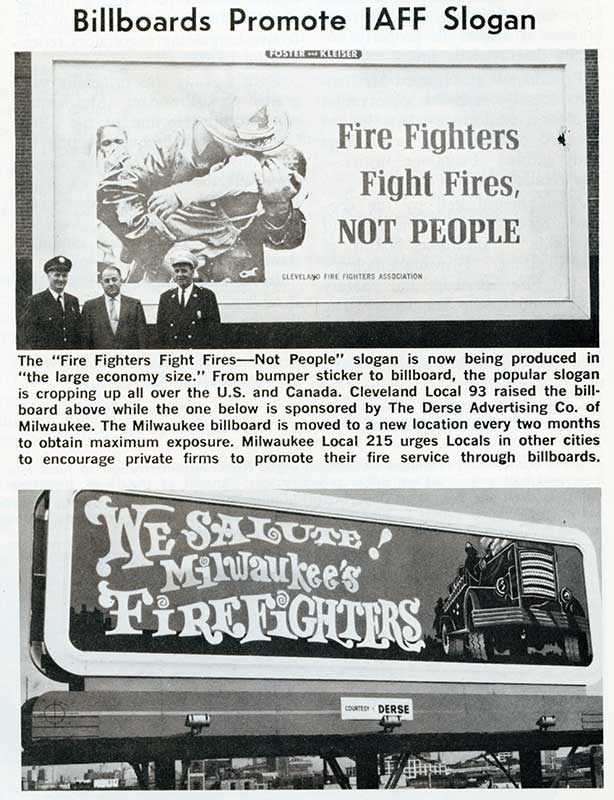
The IAFF launches a national Committee on Political Education (COPE) drive to urge all locals to set up political action committees. A contribution of $1 per union member is requested.
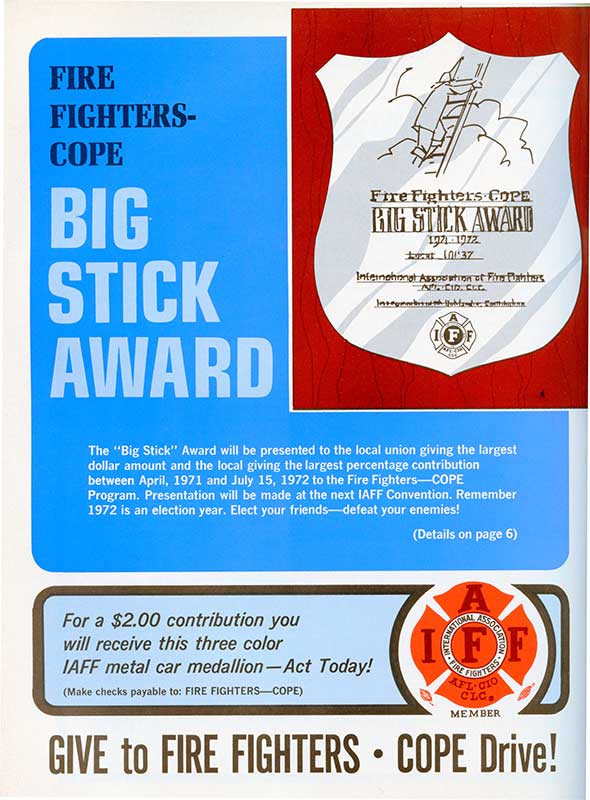
The IAFF begins a campaign asking all locals to support fire fighters whose homes were damaged or destroyed by Hurricane Camille in Mississippi.
A widow of an Ontario, Canada, fire fighter wins a pension. She is assisted in making her case through information in the John P. Redmond library.
More than 70 percent of IAFF members receive an annual salary below what the U.S. Department of Labor considers a “moderate standard of living.”
Four fire fighters are killed in Wichita, Kansas. On the night of November 21, the fire chief, chief fire inspector and two fire fighters were killed in a mass disaster when the roof of a burning building collapsed. The four fire fighters had entered the burning repair building of an auto dealership to seek out and extinguish a blaze in a space between a false ceiling and a roof. The roof caved in on them unexpectedly, trapping them beneath falling steel beams and debris.
A disturbing pattern of attempted ‘divide and conquer’ is emerging in the dealings of some city managers with the IAFF. Many city managers are attempting to demand that fire service officers drop their memberships in [the IAFF] or to ‘insist’ they move to separate local unions. They want to weaken the IAFF. We absolutely are not going to go along with them!
William H. McClennan, IAFF President (1968-1980)
An in-depth study, “The American City and Its Organized Employees,” reports that fire fighters are among the most heavily organized occupational group among all municipal employees.
The IAFF, along with four other International unions, acquires land for a new headquarters at the intersection of New York Avenue and 18th Street, NW in Washington, DC.

The backs of firetrucks are enclosed with special shatter proof gates to protect fire fighters from acts of civil disobedience.

The IAFF revises its Model Pension Plan for locals to help set up their own pension programs.
1,059 fire fighters participate in 11 IAFF education seminars in 1969.
The IAFF unites with the entire labor movement in its battle with General Electric Corporation in opposition to its inflexible “take it or leave it” bargaining stance. Membership is asked to not buy GE products and to contribute $1 each towards the GE Strike Fund to aid the 150,000 strikers at the company’s 280 plants in 33 states.
U.S. President Richard M. Nixon names IAFF President William H. McClennan as the first member of the National Commission on Fire Prevention and Control. Eighteen other members are appointed in November, a major milestone towards implementation of the Fire Research and Safety Act of 1968.
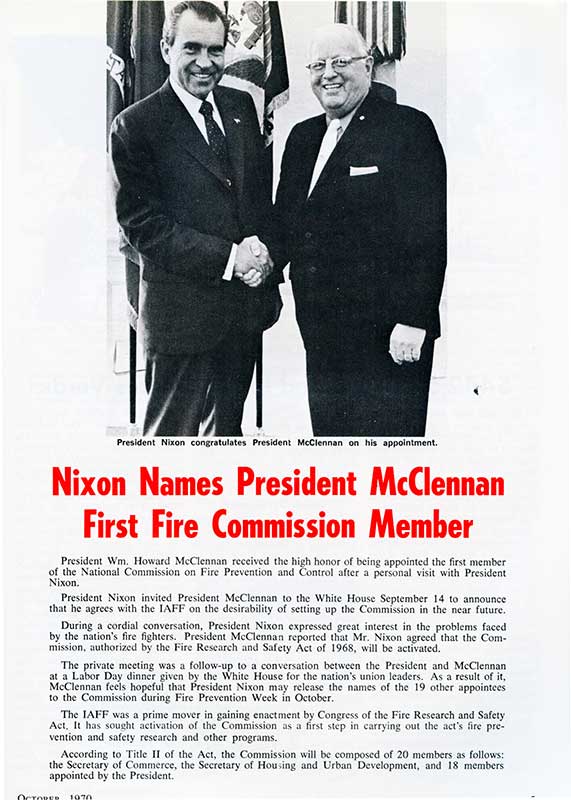
The IAFF helps draft the National Public Employee Relations Act, H.R. 17383, introduced in Congress to ensure collective bargaining for public employees.
The IAFF Ladies’ Auxiliary sets its political agenda, which includes a fully employed, prosperous economy, national health insurance, clean and modern cities, the abolition of poverty and environmental pollution and unlimited free public education through the college level.
Seven physician trustees of the John P. Redmond Memorial Fund meet on how to obtain more factual information about fire fighters’ injuries and deaths and to make plans for future research in this area.
The “11th Annual IAFF Death and Injury Survey” shows firefighting as the most hazardous occupation for the first time, eclipsing previous front-runners: mining and quarrying professions.
IAFF Legislative Representative Jack Waller and IAFF Federal Representative Al Davis testify before the House Post Office and Civil Service Subcommittee on Retirements, Insurance and Health Benefits, stating that firefighting is now considered the most hazardous occupation in the world by the U.S. Department of Labor. This finding has implications for federal fire fighters who are required to handle deadly chemicals and radioactive materials, in addition to performing their firefighting duties.
The IAFF, along with the IAFC, requests that U.S. President Richard Nixon issue an official proclamation recognizing May 9 as Fire Service Recognition Day and to sign a bill calling for awarding of a Medal of Honor annually to a fire fighter or police officer who has distinguished himself through an uncommon act of bravery.
The 30th IAFF Convention is held in Miami Beach, Florida. Delegates pass the “one man, one vote” resolution. William H. McClennan is re-elected president and Albert E. Albertoni is re-elected secretary-treasurer.
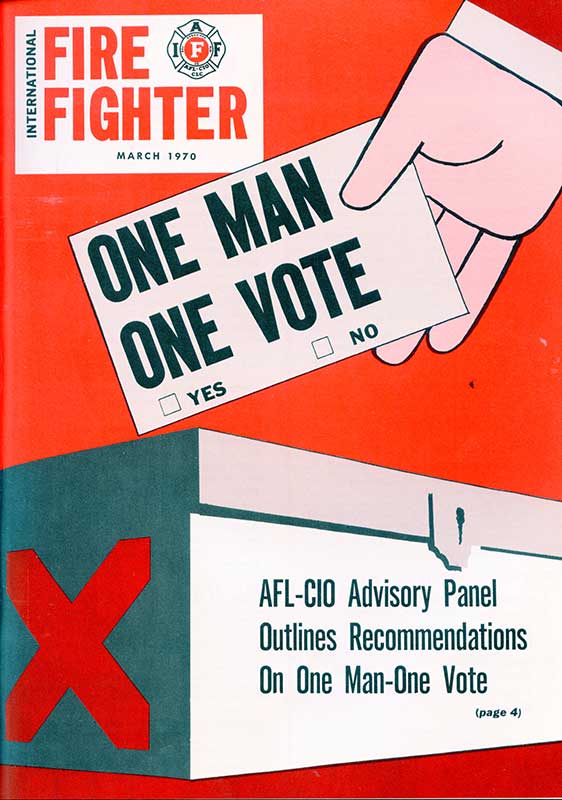
A new 28-minute movie, “A Fire Fighter’s Story – Prevent, Protect, Preserve,” is premiered at the IAFF 30th Convention. Copies can be purchased by locals for $195 each.
The entire IAFF constitution is translated into French for the first time in the International union’s history.
According to the IAFF “52nd Annual Fire Department Salaries and Working Conditions Survey,” 67 cities in the U.S and Canada pay their fire fighters a salary of $10,000 or more.
Facial hair among fire fighters is opposed by the Chief of the Waterbury (Connecticut) Fire Department. The State Board of Mediation and Arbitration finds no evidence that the fire fighter’s beard is a safety hazard, but only after he has shaved it off.
Fire fighters who are not clean shaven are working under hazardous conditions in that long hair impairs the fire fighter’s helmet and affects breathing under a gas mask and that sparks flying on unshaven faces could cause severe complications. In view of the above, I hereby order all members of our department to have short haircuts and be clean shaven.
Chief Joseph Maloney, Waterbury, Connecticut Fire Department
Delegates to the 30th IAFF Convention vote to increase the per capita tax by 25 cents for a total of $1.25, of which 10 cents will go to financially assist in the resolution of emergency disputes.
The IAFF requests that locals send copies of all union contracts and arbitration and fact-finding briefs to the Research and Education Department.
The IAFF collects fire fighter shoulder patches to be featured in a display planned for its new office building under construction in Washington, DC.
The IAFF calls for the development of an adequate smoke mask for routine firefighting as current air masks have several disadvantages – too heavy, too bulky and not long lasting.
U.S. President Richard M. Nixon vetoes the fire fighters’ retirement bill, impacting the future lives of 11,000 federal fire fighters. The bill is later reintroduced and IAFF leaders urge its passage.
The IAFF re-publishes an article from Parade Magazine describing the undeclared war on the nation’s firemen. Parade is one of several publications to focus on public attention on the “plight of the nation’s fire fighters who must not only fight fires but rocks and sticks and verbal abuse.”

IAFF President William H. McClennan writes to U.S. President Richard M. Nixon in response to his proposal to submit to Congress a bill that would provide $50,000 for beneficiaries of police officers who are killed in the line of duty. He requests that the bill be extended to include fire fighters as well.
U.S. President Richard M. Nixon signs the 1971 Supplemental Appropriation Bill, which includes $50,000 to fund the initial implementation of the Fire Research and Safety Act of 1968.
The IAFF and the U.S. Department of Labor sign an historic fire fighter recruitment and training contract totaling $425,000.
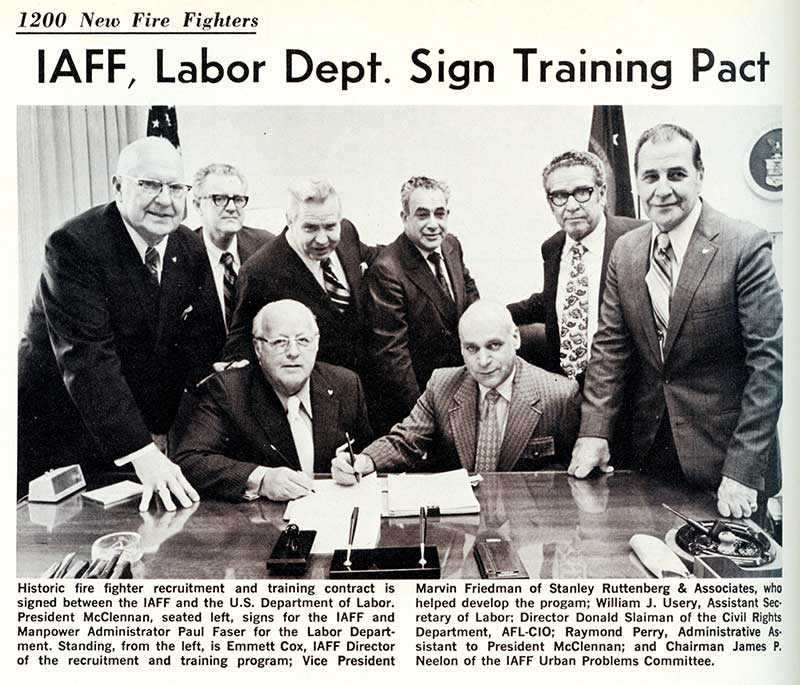
IAFF President William H. McClennan expresses opposition to a U.S. Civil Service proposal to rewrite position descriptions of fire fighters to include duties not related to their abilities and training and in no way related to fire prevention or fire suppression.
More than 300 delegates attend a symposium sponsored by the John P. Redmond Memorial Fund on occupational health and hazards facing the fire service. The theme of the symposium is “Survival.” Topics include physical standards, heart disease, pulmonary and respiratory problems, protective equipment and vehicular design, training, safety education and recordkeeping and emergency care.
In a landmark event, our John P. Redmond Memorial Fund sponsored the first national Symposium on Occupation Health and Hazards of the Fire Service … for the first time, fire fighters, fire chiefs, doctors, scientific researchers, government officials and others sat down together in the spirit of honest give-and-take and with a sincere desire to achieve a common goal.
William H. McClennan, IAFF President (1968-1980)
Fire fighters throughout the nation contribute more than $100,000 to the 1971 Jerry Lewis Muscular Dystrophy Telethon.
Four Atlanta, Georgia, fire fighters die battling a blaze May 29 at the Davis Brothers’ Restaurant in downtown Atlanta. The fire broke out after 11:00 p.m. and the sudden blast ripped the building apart, killing the four fire fighters. An additional 23 fire fighters were injured.
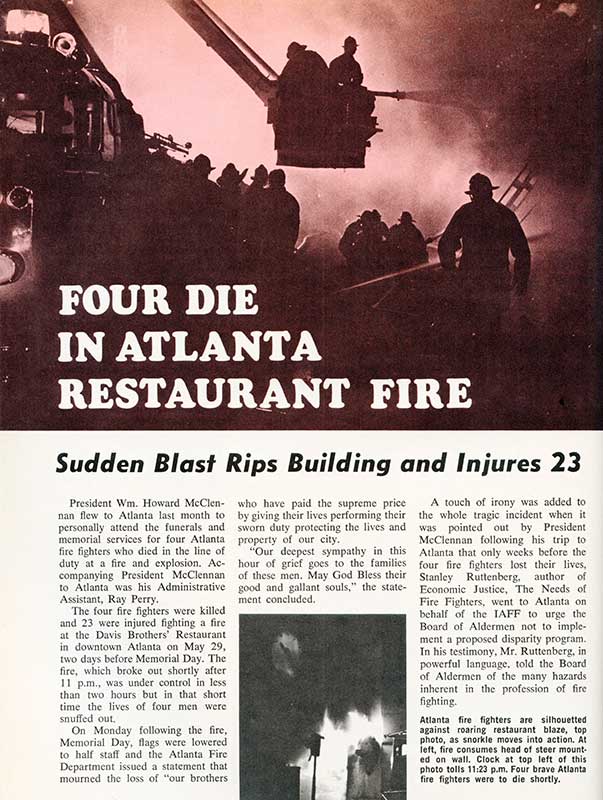
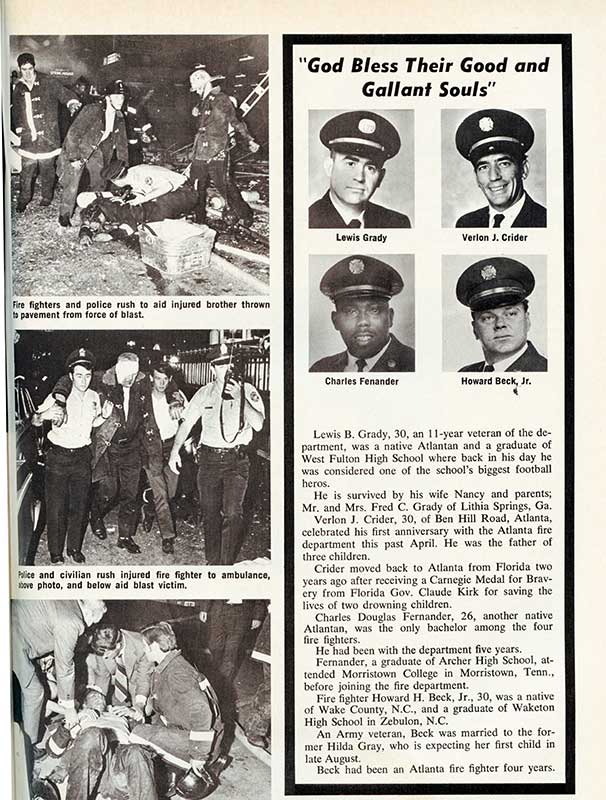
IAFF membership exceeds 150,000, achieving a goal set forth at the 1970 IAFF Convention. Fire fighters join the IAFF at the rate of 600 per month.
The IAFF states that withdrawal membership cards should never be issued to a brother who quits the union but remains in the fire service.
The IAFF makes a new watch available to members for $25, which includes the cost of postage, special packaging and insurance.

The IAFF supports congressional bill H.R. 5266 calling for a new commemorative stamp to honor fire fighters and mark the 100th anniversary of the Chicago fire.
The IAFF charters its 2,000th local: Howard County, MD Local 2000.
A new IAFF lapel pin featuring the United States and Canadian flags is available to members. The gold-plated pin costs $2.50 and the 10-carat gold pin sells for $6.50.
The IAFF contends that U.S. President Richard M. Nixon may be the strongest single unifying force for American labor in years.
The IAFF joins the Coalition of Public Employee Organizations to form an action program with an emphasis on legislation, legal problems and increased political involvement during the national election year.
The IAFF holds it 31st Convention in Los Angeles, California. IAFF Secretary-Treasurer Al Albertoni decides not to run for a fifth term of office. Albertoni promised his wife and family at the IAFF Convention in Toronto in August 1968 that he would stand for re-election one more time and then relinquish this office for a less complex life in retirement. Frank Palumbo is elected IAFF secretary-treasurer. Delegates debate a record 189 resolutions.

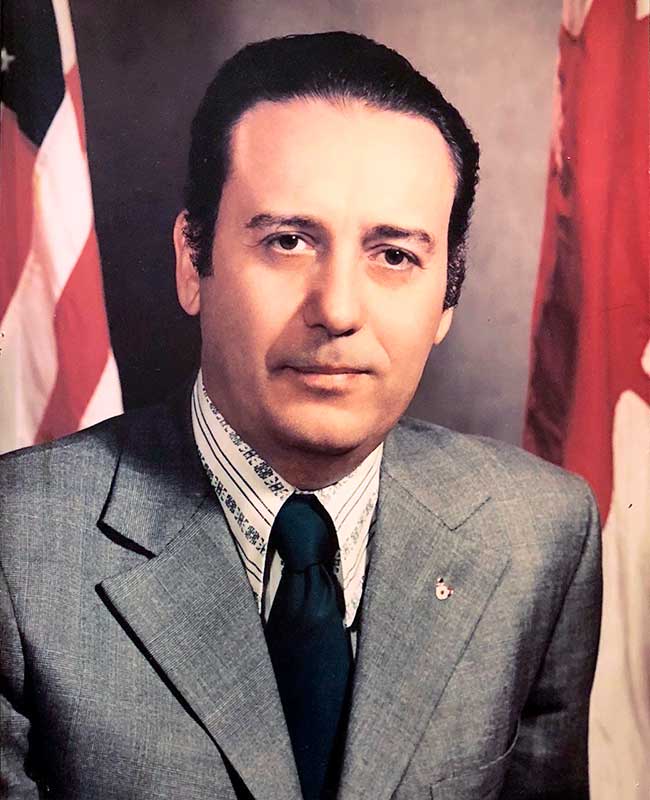
U.S. President Richard M. Nixon names IAFF Secretary-Treasurer Al Albertoni as one of five new members to the Board of Vocational Education. He is the only representative of organized labor on the nine-member Board.
U.S. President Richard M. Nixon signs the Hazardous Duty Retirement Bill, PL 92-382, for federal fire fighters into law.
The number of members of minority groups in the populations of many of our larger cities is out of proportion to the number of people from those minorities that are in the ranks of the fire service.
William H. McClennan, IAFF President (1968-1980)
The IAFF petitions the Pay Board and the State and Local Government Committee of the Cost of Living Council for justice and fair pay for fire fighters.
The Department of Labor’s Public Employment Program agrees to major policy changes requested by the IAFF related to overtime pay, including deletion of the 10 percent limitation on recalls in the revised Public Employment Program (PEP) Handbook and allowing Program Agents to reduce hours to a reasonable minimum of 40 hours per week since fire fighters generally worked more hours than other public employees. Hours worked over and above 40 hours per week may be considered overtime, even if they are not compensated as such, since the normal work week in public service is 40 hours.
A new television series, “Emergency,” premieres. The show is set against background operations of the Los Angeles County Fire Department’s innovative paramedic rescue squads.

Nine Boston, Massachusetts, fire fighters die June 17 as a wall collapses without warning during a seven-story hotel fire, burying the men in a mountain of rubble. Eight other fire fighters were injured, one seriously. The cause of the blaze and building collapse were undetermined.

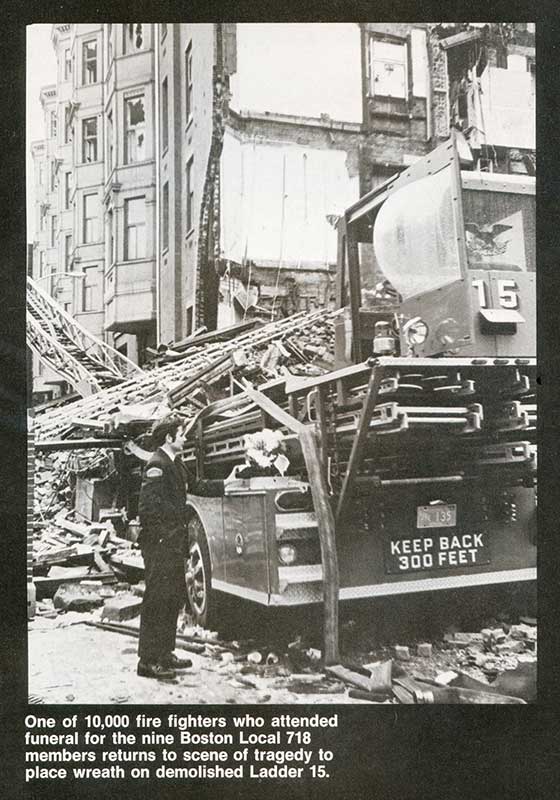
IAFF members raise more than $100,000 for the Jerry Lewis Muscular Dystrophy Telethon.
Two Little Rock, Arkansas, fire fighters die battling a fire in a three-story apartment building when a wall collapsed, and seven others were injured. The fallen men were on the right side of the fire truck when the interior floor collapsed, causing the wall to explode outward, hurling debris across the street. The $65,000 aerial truck was crushed by the weight of the wall.
Cooperation and coordination between the IAFF and the U.S. Department of Labor leads to the development and adoption of the National Apprenticeship and Training Standards for fire fighters.
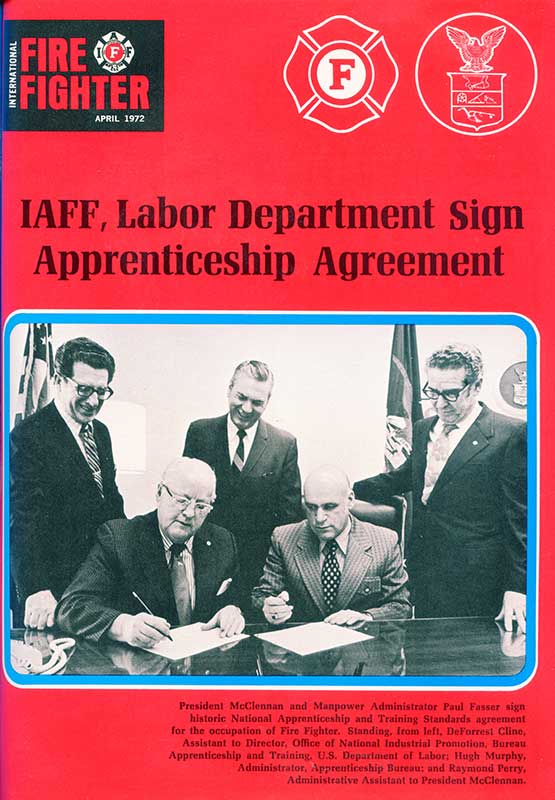
Federal workers in the United States lag far behind their Canadian counterparts when it comes to collective bargaining rights.
The IAFF moves to its new headquarters at 1750 New York Avenue, NW, Washington, DC.
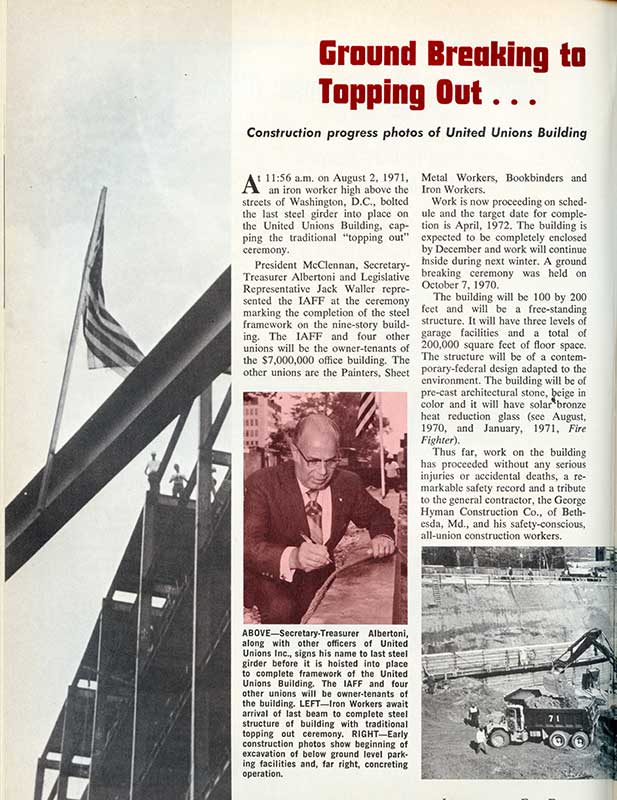

Three New Orleans, Louisiana, fire fighters are killed battling a Christmas Day blaze when an old brick wall and a wrought iron balcony collapsed with more than one dozen New Orleans fire fighters on it, killing three and injuring 14. A backdraft from the rear and an explosion of accumulated gas caused the wall to fall forward. Four of the seven abandoned buildings in the block were burned out and in the process of being demolished when the fire began.
The U.S. Department of Labor rules that fire service captains must become part of collective bargaining units as they are not supervisors.
The IAFF makes a new 10-carat gold ring available to members for $56.
On January 10, three Chicago, Illinois, fire fighters die when the roof of a cafeteria collapses as they evacuate the building. The three were buried with full departmental honors.
Two bills to establish the U.S. Fire Administration and the National Fire Academy are introduced in Congress. The IAFF wholeheartedly supports passage of these two bills and testifies at several congressional hearings.
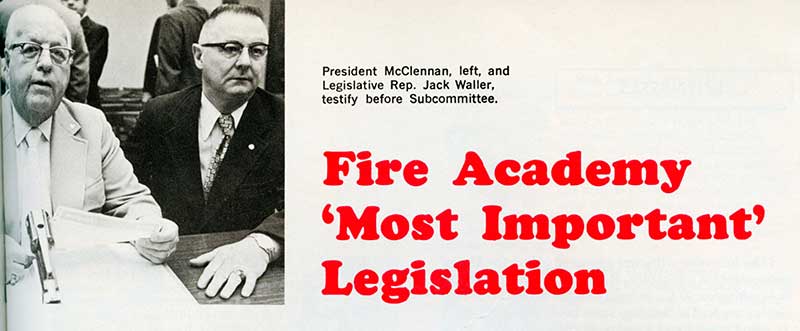
The IAFF criticizes two presidential vetoes, the first the Minimum Wage Bill and the second the “emergency medicine bill,” which would have provided training to paramedics to give emergency medical care to the sick and injured.
U.S. President Richard M. Nixon signs into law Public Law 93-154 amending the Public Health Service Act to aid communities in developing and improving comprehensive emergency medical services. IAFF President William H. McClennan urges fire fighters to take full advantage of the more than $185 million allocated.
The National Commission on Fire Prevention and Control calls for the passage of federal laws requiring sprinkler systems, fire escapes or fire towers in high-rise buildings. IAFF President William H. McClennan serves as Vice Chairman of the National Commission.
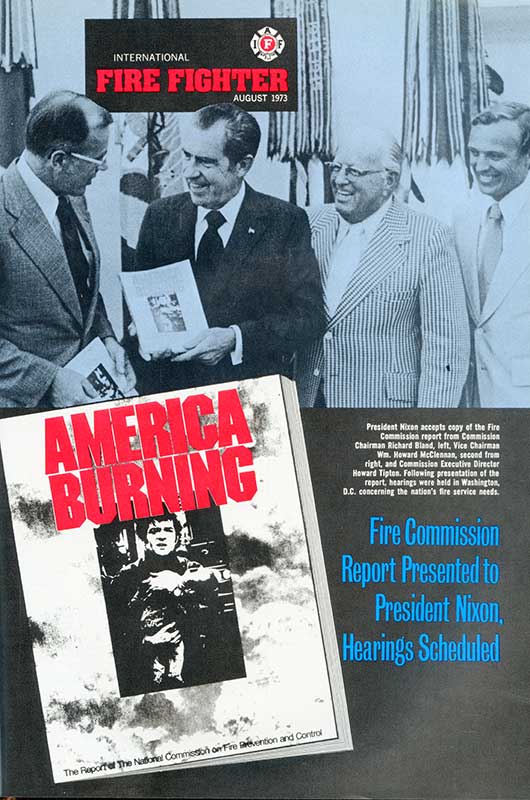
The IAFF urges all locals to participate in preparing state plans related to the Williams-Steiger Occupational Safety and Health Act of 1970. Every IAFF affiliate is asked to consider the initiation of its own Safety and Health Committee.
The IAFF, along with federal employees and their unions, pushes for passage of a collective bargaining law for civil servants in the federal service and proposes the formation of an internal Department of Public Employees to focus on bargaining rights.
Two Indianapolis, Indiana, fire fighters die when their pumper overturns on the way to a grass fire. Three others were injured, one critically, when their pumper was hit at an intersection and overturned on the way to the scene.
The IAFF reports that carbon dioxide emitted by burning fibers and plastic fumes cause smoke-related deaths among fire fighters. Tests showed that in Cambridge, Massachusetts, fire fighters were probably knocked out by a high level of carbon dioxide rather than by toxic gases. Evidence from fire tests with plastics and modern fibers shows that colorless, odorless fumes quickly displace oxygen and cause a dramatic rise in the carbon dioxide level in the atmosphere.
General Motors’ bumper systems, designed to protect many of the 1973 GM cars from low-speed impacts, pose an exploding danger. Both mechanics and fire fighters have been killed by the explosion of the impact cylinders due to overheating of the compressed gases by welding and car fires.
The IAFF “Annual Death and Injury Survey” reveals that fire fighters now can count on only a 50-50 chance of getting through a year’s work without being injured.
A question was asked by one of the younger members in a very honest and sincere manner: ‘Why do we need an International?’ My answer came without the need for much thought: ‘Because it is the very foundation of the house of labor; the bringing of all fire fighters together under one roof. And through your International, there is the promise of a better tomorrow for you and your family.’ The nodding of his head indicated that, for him, this made sense and the subject was dropped.
Frank Palumbo, IAFF Secretary-Treasurer (1972-1980)
Two projects at NASA are underway to improve fire fighters’ equipment. The first focuses on conventional design, fire-resistant, protective clothing using space technology. The second focuses on a longer-duration breathing apparatus for fire fighters.
The IAFF, in cooperation with the American Arbitration Association, produces a 23-minute film entitled, “Count the Men.” The film focuses on grievance processing and arbitration.
IAFF members staff phones to help raise more than $12 million for the Muscular Dystrophy Associations of America Labor Day Telethon. President McClennan presents a $188,368 check from fire fighters to Chairman Jerry Lewis.
IAFF Secretary-Treasurer Frank Palumbo explains how the $1.50 per capita tax on members is allocated by the International union.

Two Philadelphia, Pennsylvania, fire fighters are killed when battling a blaze at an ink manufacturing plant, and 37 others were injured, some seriously, when the South Philadelphia plant exploded at the height of an eight-alarm fire. The men were caught in the building and an adjacent storage yard when thousands of gallons of flammable solvent exploded. Bricks and debris were hurled more than a block.
Two federal fire fighters in San Diego, California, die October 23 when a JP-4 tank trailer explodes. The men were members of Local F-33, San Diego Naval Station.
The IAFF sponsors an Accidental Death and Dismemberment Insurance plan, allowing every member under age 70 to purchase policies ranging from $10,000 to $25,000 in coverage.
According to the U.S. Department of Labor, the IAFF ranks eighth among 45 unions with 100,000 or more members in making the greatest proportionate gain in membership during the period 1960 to 1970.
The IAFF urges members to support consumer boycotts against products and services of several companies which, because of their anti-union policies, do not deserve members’ patronage.
The IAFF engages in a campaign to alert physicians, fire fighters, ambulance attendants and other emergency medical personal to be aware of “Medic Alert” bracelets or necklaces and their life-saving significance.
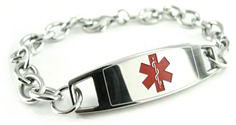
The IAFF mourns the death of former U.S. President Harry S Truman, who “will go down in history as a great friend of labor.”
The IAFF alerts members to a fraudulent organization, the “Fraternal Order of Fire Fighters,” and urges all locals to watch for this organization in their communities and to inform their local police department if they have any information regarding its purpose.
27 states have laws on their books covering employees’ rights to bargain with their employer. Four states have bargaining laws covering fire fighters only – Georgia, Idaho, Oklahoma and Wyoming.
Due in large part to IAFF advocacy, Congress includes fire fighters in the Fair Labor Standards Act, which is signed into law on April 8, 1974, by U.S. President Richard M. Nixon. The law contains special overtime provisions that include a minimum wage of at least $1.90 per hour.
U.S. President Richard M. Nixon signs into law H.R. 9281, the Hazardous Duty Retirement Bill for federal fire fighters.
California Governor-Elect Edmund G. “Jerry” Brown Jr. visits IAFF headquarters seeking the support of the nation’s fire fighters several weeks before the national elections.

The energy crisis sweeps the nation and gasoline is in short supply. The IAFF warns fire fighters to beware of gas hoarders at auto fires, as one gallon of gasoline packs the punch of 14 sticks of dynamite. The IAFF urges delegates to the 1974 Convention in Baltimore, Maryland, to consider chartering buses for transportation due to the energy crisis.
The IAFF and IAFC adopt a joint resolution to use fully the opportunities provided by the Boy Scouts of America to educate youth in the areas of fire prevention and fire safety.
Delegates at the 32nd IAFF convention approve a 13-cent per capita increase in member dues, raising payments to $1.63 per month. IAFF President William H. McClennan and IAFF Secretary-Treasurer Frank Palumbo are re-elected by the delegates.
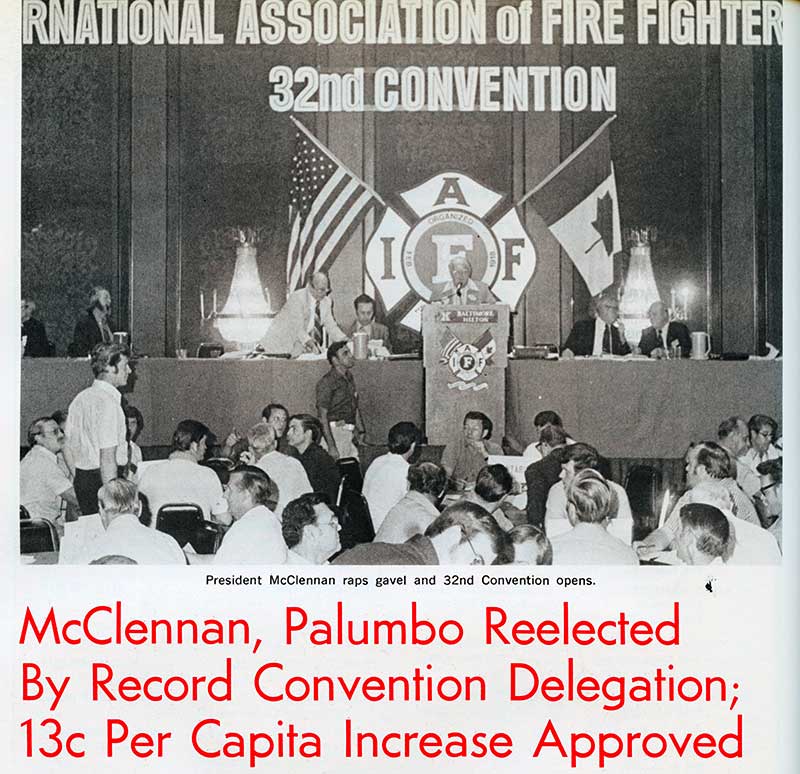
Locals and Ladies’ Auxiliaries raise more than $300,000 in support of the Muscular Dystrophy Associations of America’s Labor Day Telethon.
“The Towering Inferno” debuts in more than 200 cities in the United States and Canada. Warner Brothers and 20th Century Fox donate all net proceeds from the premiere showing to the IAFF Scholarship Fund.
Two West St. Paul, Minnesota, (Local 1059) fire fighters are killed by an exploding propane gas tank as they battle a blaze at an apartment house complex.
At the 1974 Convention, President McClennan swears in newly elected officers of the Ladies’ Auxiliary.

Secretary-Treasurer Frank Palumbo represents the IAFF on the National Professional Qualifications Board of the Fire Service to develop a national standard for fire fighter qualifications. A minimum standard is unanimously approved.
The U.S. Department of Labor awards the IAFF a $31,150 grant to help finance a collective bargaining manual for public employee unions.
The IAFF and the National Bureau of Standards outline their preliminary draft for state standards for fire fighters’ turnout coats, including their size, stitching, material, color, collar and pockets.
The “Med-E-Train” manikin is developed to assist in the training of emergency medical personnel. An indicator light is provided to show the proper technique for CPR and mouth-to-mouth resuscitation. Control of bleeding, diagnosis of vital physical signs and a simulated fractured bone are also featured.
The lifeblood of our union is our dues-paying members and the servicing of these members. We have 170,000-plus members now. By the time the Denver Convention rolls around, I would like to see our membership at the 200,000-member mark. Go out and sign up that unorganized member, or members, in your department and we can do it easily.
William H. McClennan, IAFF President (1968-1980)
Secretary-Treasurer Emeritus George J. Richardson completes a history of the IAFF, Symbol of Action. Pre-publication copies may be ordered for $10.
The Muscular Dystrophy Associations of America dedicates a new summer camp in Haverhill, Massachusetts, in honor of the IAFF, a consistent supporter of MDAA. The camp is named after St. Florian, patron saint of fire fighters.
The IAFF announces the availability of a new group life insurance plan for members with benefits ranging from $5,000 to $30,000.
U.S. President Gerald Ford appoints IAFF President William H. McClennan to the National Commission on Productivity and Work Quality.
The IAFF opposes the nomination of John L. Peterson – a volunteer fire fighter – as the U.S. Fire Administrator, stating the nominee lacks experience, contacts, philosophy, vision and purpose about the fire problems. He urges members to write to President Gerald Ford and members of Congress to ask that Peterson’s nomination be withdrawn. Based partially on IAFF support, the U.S. Senate confirms Howard Tipton as the first administrator of the U.S. Fire Administration.
Legislation to provide a $50,000 death benefit for fire fighters and police officers dies in the 93rd Congress. The IAFF testifies at a congressional hearing in support of the death benefit.
The IAFF launches FIREPAC (Fire Fighters Interested in Registration and Elections Political Action Committee) to raise money to help elect deserving freshmen to Congress in 1976. FIREPAC coupons cost $1.
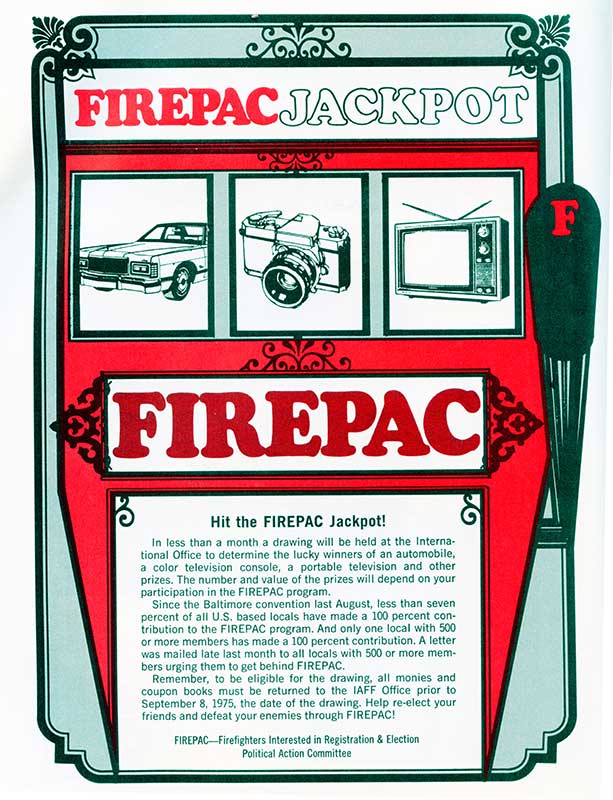
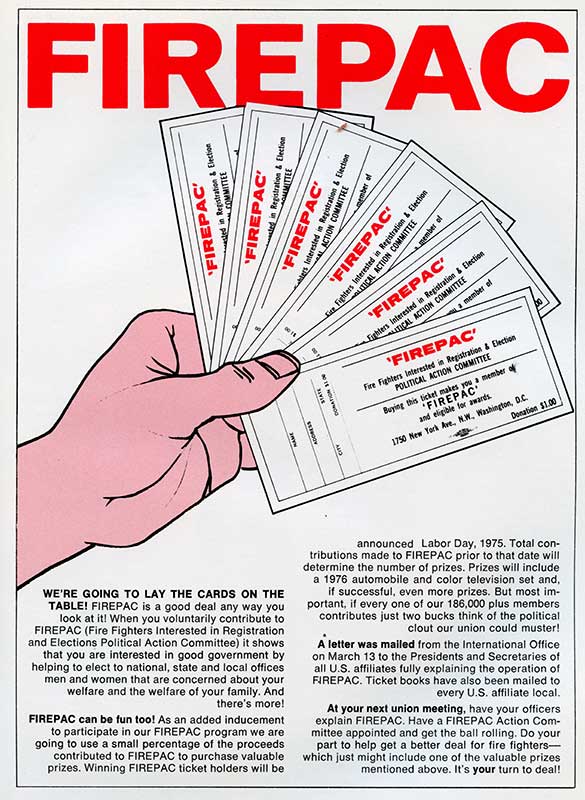
The U.S. Supreme Court hands down a decision on the case involving the right of fire fighters and police officers to be covered by the U.S. Fair Labor Standard Act. The Chief Justice calls for the case to be re-argued.
Congress introduces a bill that, if enacted, would provide emergency financial assistance to cities and municipalities that have been forced to reduce their firefighting and police forces.
The IAFF supports the Burn Facilities Act of 1975, H.R. 8121, which calls for the appropriation of $90 million over a three-year period for the establishment of 12 burn treatment centers and 24 smaller burn units.
The IAFF and IAFC receive a $130,000 contract from the U.S. Department of Labor to establish an apprenticeship training program within fire departments throughout the United States.
For the first time in history, simultaneous translation of French and English is instituted at a Canadian conference.
In the last 10 years we have grown some 50 percent! Our founding convention, reflecting a high degree of singleness of purpose, lasted only 44 minutes!
William H. McClennan, IAFF President (1968-1980)
The IAFF launches a program designed to encourage expansion of governmental research on burns, the treatment of burn injuries and the rehabilitation of burn victims.
The IAFF reports that fire fighters’ disability pensions are completely non-taxable.
The International Fire Fighter unveils a new feature, “IAFF Bulletin,” drawing content from various local publications that IAFF headquarters receives.
Eight Philadelphia, Pennsylvania, fire fighters are killed August 17 in an oil refinery holocaust. The tanker “Afro Neptune,” anchored in the Schuylkill River, was piping Venezuelan crude oil to a large storage tank located at the south corner of the refining complex only 200 feet away from the Penrose Avenue Bridge.
The pipeline ruptured, spilling the crude oil and causing an explosion. Eight fire fighters died in a flaming pool of oil that suddenly flashed around them during the multi-alarm fire at the Gulf Oil Refinery. An additional 17 fire fighters were injured. The fire burned itself out by the middle of the week, causing $10 million in damage to the 400-acre plant.
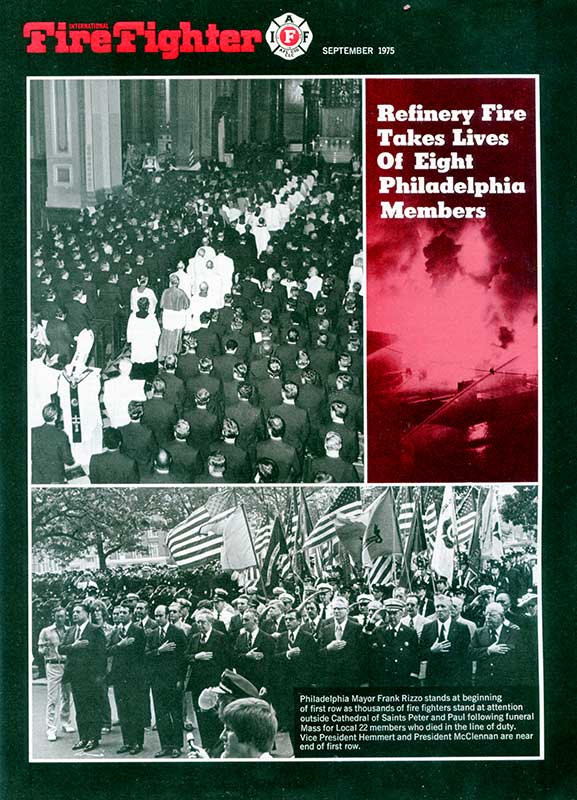
In September, three Binghamton, New York, fire fighters drown during a rescue attempt in the flood-swollen Susquehanna River. One fire fighter lost his life when he tried to rescue two young men who had ridden over Rockbottom Dam in a raft. The two men made it safely to shore, but the fire fighter was lost and presumed drowned. Two other fire fighters set out to locate and rescue him, but they died in the raging eddies of the river when their boat capsized and was sucked into the spillover of the dam.
The IAFF “1974 Annual Death and Injury Survey” reveals that fire fighters are once again first in accidental work deaths per 100,000 persons.
The IAFF urges all U.S. affiliates to take advantage of the $185 million allocated to develop or improve emergency medical services in their communities by encouraging and informing public officials of the fund, which stems from the amendment to the Public Health Service Act, Law 93-154, signed by President Richard M. Nixon in 1973.
NASA develops a Fire Fighters Breathing System (FBS), a new light-weight, long-duration breathing device with an improved face mask and tank.
A preliminary study sponsored by the U.S. Department of Labor shows that a compulsory arbitration law in at least one state has been effective in helping police and fire fighters resolve disputes with their employers.
The IAFF has a direct line open to receive contributions from locals while the 1975 Muscular Dystrophy Association Jerry Lewis Labor Day Telethon is on the air. IAFF representatives make five spot appearances on the telethon. IAFF members raise at least $1,148,803 – a record amount.

The IAFF Executive Board adopts nine recommendations issued by its Policy Committee regarding paramedic programs. Board members agree that every community is entitled to this type of emergency medical service and that it should be within the jurisdiction of the fire department.
A second-generation fire fighter uniform is made of flame-resistant cotton. New features include low shrinkage, high fabric integrity and color retention.
A new $6,000 hydraulic device called the Jaws of Life spreads apart crumpled metal to free people trapped in wrecked cars or behind jammed elevator doors.
The 93rd Congress rules that fire fighters are eligible to collect unemployment compensation.
The Ford administration’s proposed budget poses an economic threat to all public employees and a continuing financial crunch for state and local governments.
IAFF President William H. McClennan calls on the Democratic Party Platform Committee to urge party candidates to denounce the increasing malicious attacks that are threatening the welfare and undermining the morale of the nation’s public employees.
IAFF President William H. McClennan endorses the Democratic candidate for president, Jimmy Carter. He meets with Mr. and Mrs. Carter at a private conference in Atlanta, Georgia, a few days before the IAFF 33rd Convention. Newly appointed IAFF Legislative Representative Harold Schaitberger arranges the meeting.
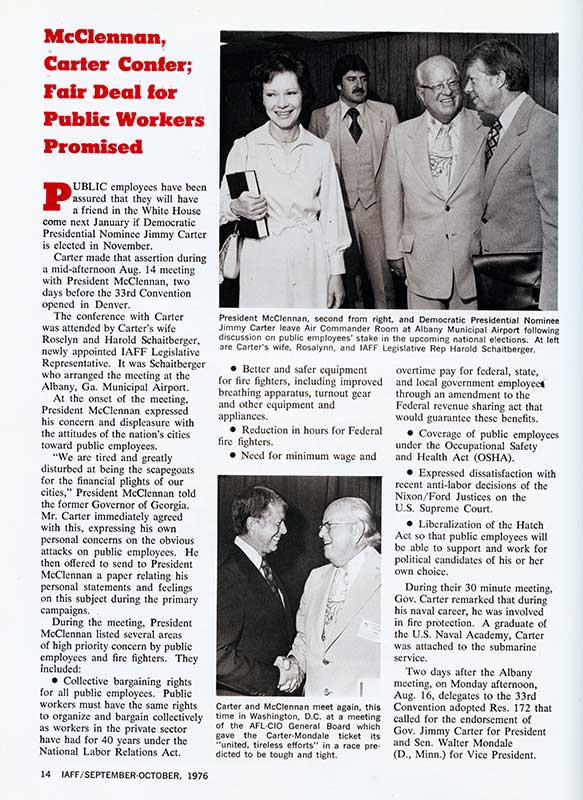
Fire fighters in depressed cities breathe easier as Congress overrides U.S. President Gerald Ford’s veto of the Publics Works Bill, making up to $3.95 billion in new funds available.
After an eight-year battle in the U.S. Congress, the IAFF pushes through a landmark piece of legislation to provide $50,000 in death benefits to the survivors of fire fighters and police officers killed in the line of duty. U.S. President Gerald Ford signs the bill, H.R. 366, into law on September 29.
The U.S. Supreme Court rules that employers may set hair standards for employees.
The IAFF holds its 33rd Convention in Denver, Colorado. IAFF President William H. McClennan and IAFF Secretary-Treasurer Frank Palumbo are re-elected.
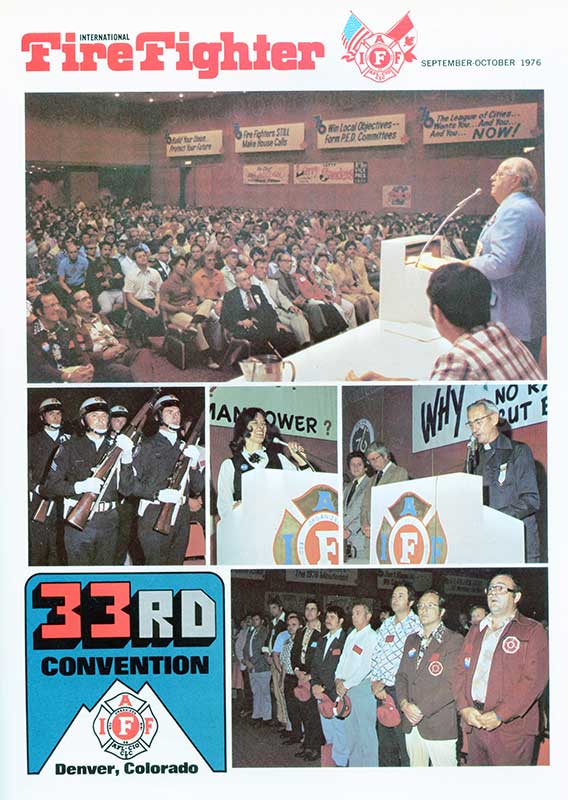

The IAFF legislative agenda for the 95th Congress includes reduction of hours for fire fighters, re-classification for federal fire fighters, income tax deduction for meals and scholarship funds for dependents of fire fighters killed in the line of duty.
The first in a series of reports for the “IAFF Safety and Health Kit” is released, providing specific standards for fire fighters’ helmets, boots, fire coats, protective trousers, respiratory devices, station uniforms and gloves.
The IAFF promotes an Emergency Medical Data Card to members. Medical history is microfilmed and lists drug hypersensitivity, allergies, blood types, operations, cardiovascular, epileptic or diabetic conditions, contact lenses, medical records and more. It costs $4.00 for members and $4.50 for members’ families.
The IAFF has a direct telephone line open during the 1976 Jerry Lewis Labor Day Telethon to accept contributions from locals during the broadcast. IAFF members contribute $1.6 million to MDAA.
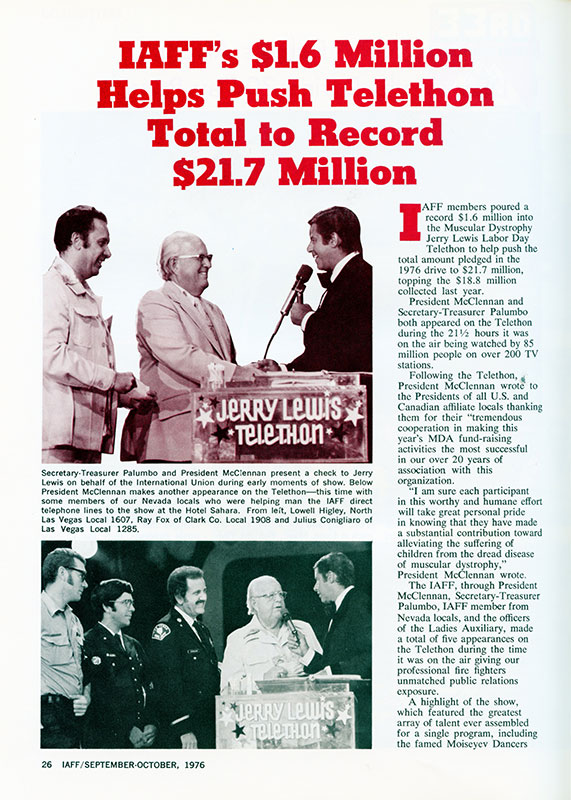
The IAFF receives a $120,000 grant from the National Fire Protection and Control Administration for a 14-month comprehensive study of “Fire Fighter Injuries and Injury Reporting Systems.”
The IAFF “Annual Death and Injury Survey” reveals that fire fighters suffer 90 accidental deaths per 100,000 workers – the highest of any profession.
Three Massillon, Ohio, fire fighters die and another is injured November 30 in a fatal restaurant blast. Fire investigators found several plastic containers and detected a strong odor of gasoline. An arsonist is charged with three counts of aggravated murder.
Any man who dedicates his life to professional firefighting would be a fool if he did not realize the dangers of his profession and the possibilities of injury and even death. This, more than any other reason, is why fire fighters across this nation have given up, in any number of contract negotiations, sorely needed dollars in return for the insurance and other benefits that would aid the family if the ever possible happens.
Frank Palumbo, IAFF Secretary-Treasurer (1972-1980)
Four Philadelphia, Pennsylvania, fire fighters are killed August 17 when a floor collapses while they fight a blaze in a delicatessen. The fire, of undetermined origin, apparently began in the basement of the delicatessen.
Five Alabama fire fighters are killed in two separate incidents. Three die in Gadsden when an above-ground gasoline storage tank explodes without warning as they fight a fire at a filling station. Two others die in Tuscaloosa from smoke inhalation while fighting a fire at a paper mill.
$240 million in Comprehensive Employment and Training (CETA) funds for emergency public service jobs is allocated to state and local governments to continue 260,000 public service jobs until February 1977. Another $960 million had been previously allocated to forestall threatened layoffs of federal subsidized employees.
The U.S. Bureau of Labor Statistics reports a dramatic difference between wages and fringe benefits received by union and nonunion workers.
The IAFF sends a strongly worded protest on behalf of professional fire fighters to the Carnation Milk Company in opposition to a television commercial depicting a fire fighter munching on an “instant breakfast” bar as he is leaving his station to answer an alarm, suggesting that professional fire fighters do not respond immediately to an alarm. Carnation cancels the television commercial.
The U.S. Census Bureau reports that more than half of all full-time state and local government workers are members of unions or associations that function as unions. Fire fighters are the most highly organized with a 74.4 percent membership.
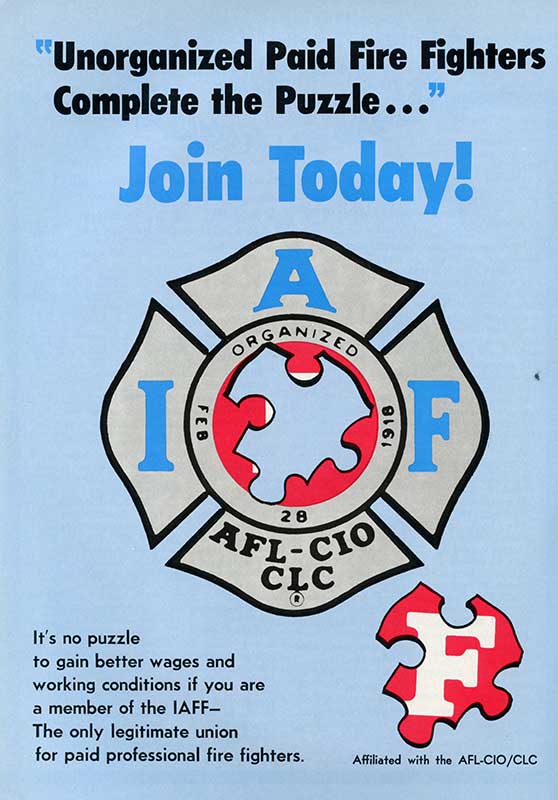
The IAFF asks all locals and state and provincial affiliates to provide the names of individual members involved in community and civic affairs, as well as those who have won, or presently hold, elective or appointive office on a state, county or municipal level.
The Socorro (New Mexico) Fire Department is cited for discrimination. The employer is required to remedy discrimination by recruiting, hiring and assigning women to that department. It is also required to advertise positions in newspapers and to keep records of all recruitment efforts and applications with submission of annual reports to the Equal Employment Opportunities Commission (EEOC).
The IAFF publishes a new 93-page manual, “The Use of Economic Data in Collective Bargaining,” to help locals in dealing with complex issues involved in the collective bargaining process.
The members of Washington, DC Local 36 participate in a 12-week bicentennial salute to American workers at the Annual Festival of American Folklife held on the National Mall in the Nation’s Capital.
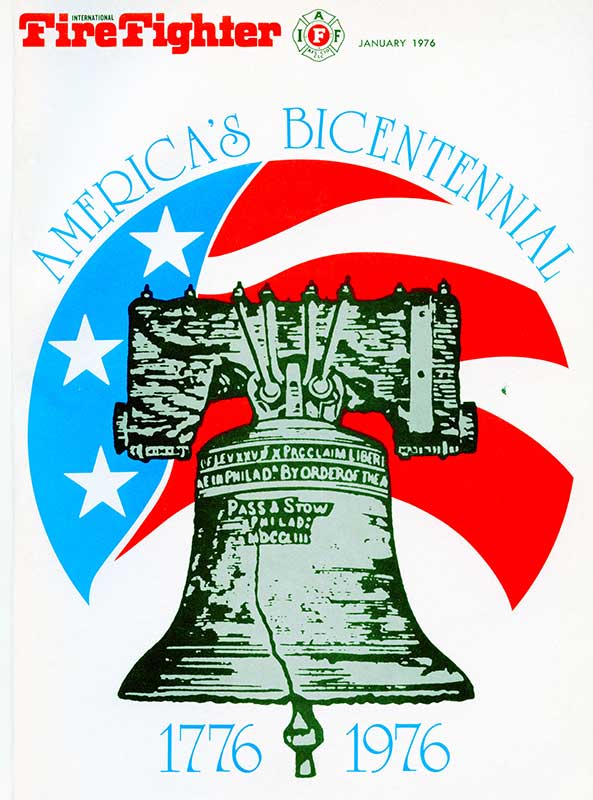

The “Clemens Hook” is developed by a Prince George’s County, Maryland, fire fighter. The seven-pound hook is a modification of the pike pole, but is stronger and more versatile because it has a molded fiberglass handle and a steel tip that can punch, pry, cut and force.
Five IAFF representatives are serving as technical advisers and committee members for “Project Fires,” a recently inaugurated $1.2 million research and development program aimed at drastically improving the protective clothing and personal equipment worn by fire fighters.
The IAFF censures Reader’s Digest for publishing a five-page article calling for a full mobilization of public opinion against any national law to legalize collective bargaining in the public sector.
IAFF President William H. McClennan becomes the first fire fighter elected to the AFL-CIO Executive Council.
The U.S. Congress passes the most sweeping tax reform law in United States’ history. IAFF Secretary-Treasurer Frank Palumbo highlights key provisions, including sick pay exclusions, tax credits for the elderly, other retirement benefits, moving expenses and child care expenses, among others.
The New Year finds us with a new president, new Congress, new Cabinet officers and a new chairman of the Civil Service Commission and, most important of all, 1977 finds us with new hope to achieve our legislative goals.
Fred Schillreff, IAFF Staff Representative
The IAFF Executive Board establishes a new IAFF Scholarship Fund to provide money for the education of children of fire fighters killed in the line of duty. The IAFF holds a $100-a-plate Scholarship Fund Banquet. More than 600 attend the event.

The IAFF helps sponsor a four-day Congressional Tour of New York City to enable congressmen to observe first-hand the myriad problems that beset large cities’ firefighting efforts.
The IAFF strategizes and lines up support for many worthy fire service and related bills in the congressional hopper. Hearings take place regarding Hatch Act amendments and collective bargaining for federal employees (as well as state and local employees).
IAFF locals raise a record $2,120,000 for the Muscular Dystrophy Association of America as part of the Jerry Lewis Labor Day Telethon.
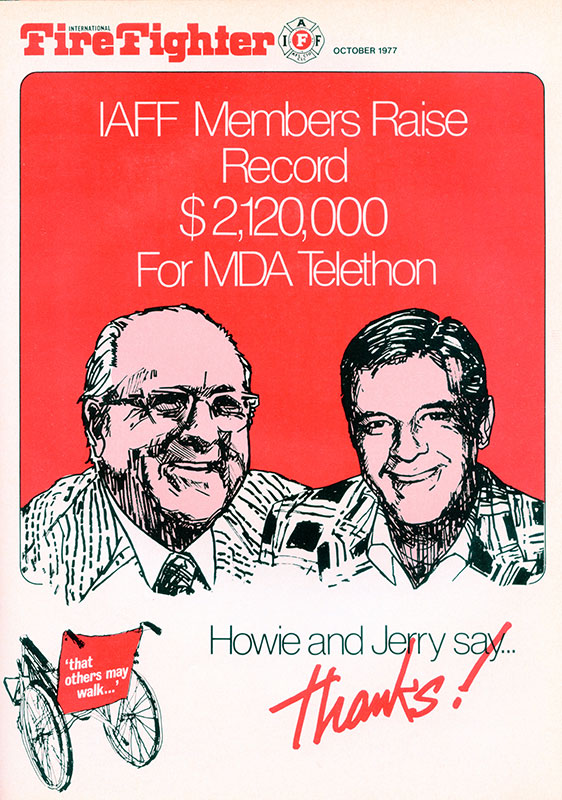
Canadian fire fighters raise $250,000 to support a burn facility in Windsor, Ontario.
The U.S. Department of Labor awards the IAFF and IAFC a $1,250,000 grant for the development, promotion and implementation of a standardized, nationwide apprenticeship program for emergency medical technicians.
The IAFF signs a $454,815 contract renewal with the U.S. Department of Labor to help prepare 890 minority group members in 13 cities to pass examinations for firefighting jobs.
IAFF President William H. McClennan forms a “President’s Club” to garner more resources to support the FIREPAC Fund. Donors are awarded the new official IAFF cloth-embroidered patch.
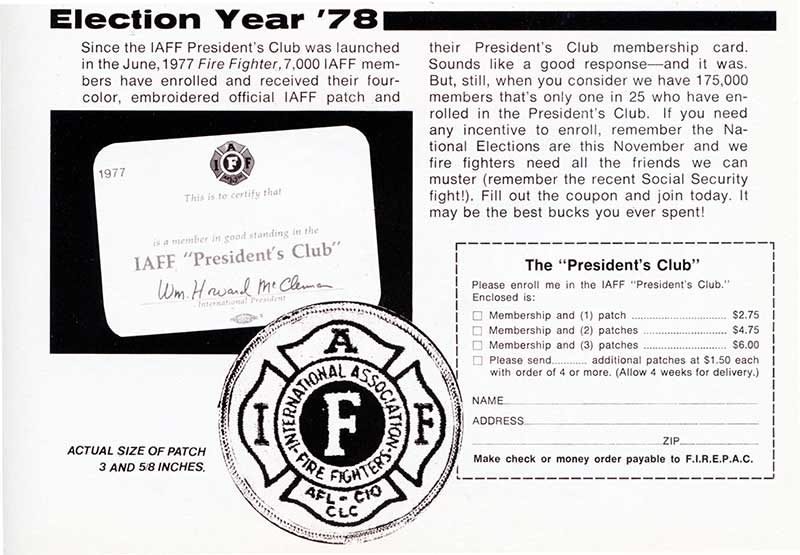
IAFF President William H. McClennan accepts a federal grant for $157,032 from the National Fire Prevention and Control Administration for a combination correspondence and open university course that leads to a degree for fire fighters from an accredited university.
The IAFF creates a series of print public service announcements aimed at three issues important to the fire service: staffing, fair pay and consolidation. Sets of six sheets of ads can be ordered from the IAFF for $2.50.


The IAFF Executive Board appoints a three-man committee to study the feasibility of organizing U.S. and Canadian police officers.
IAFF members who have completed 30 or more years of service can obtain a gold-filled, 30-year emblem pin for $6.00.
The IAFF expresses its condolences on the death of former U.S. Vice President Hubert H. Humphrey, credited with pushing fire fighter legislation in Congress.
IAFF President William H. McClennan praises U.S. President Jimmy Carter’s proposal for a thorough reorganization of the federal civil service system. President Carter also publicly endorses various moves to strengthen the role of collective bargaining in the federal government.
The Joint Council of National Fire Service Organizations vote unanimously – but conditionally – to support a proposal by U.S. President Jimmy Carter’s team to transfer the National Fire Prevention and Control Administration to the new Federal Emergency Management Agency (FEMA) that will report directly to the president.
Throughout the United States and Canada, the IAFF is in healthy condition as it moves towards its 60th birthday. We have a high degree of unity, we’ve gained valuable organizing and collective bargaining experience, we’re increasingly effective in our communities and in the state and provincial capitals. In other words, we have a lot to be optimistic about. So, let’s have a happy 1978 … and roll the union on!
William H. McClennan, IAFF President (1968-1980)
U.S. President Jimmy Carter vetoes a bill passed by Congress to cut the federal fire fighters’ hours from 72 to 56 per week, deeming it inflationary. The IAFF refutes President Carter’s claim and expresses disappointment in his decision.
Organized labor and the nation’s business community wage guerrilla warfare on Capitol Hill over Labor Reform Law, S. 2467. The IAFF launches a full-scale legislative push to protect fire fighters nationwide.
The 1978 IAFF legislative goals include National Fire Academy funding, establishment of Memorial Sunday for fire fighters disabled or killed in the line of duty, Hatch Act amendments and reductions of federal fire fighters’ workweek.

The House Post Office Civil Service Committee votes to attach H.R. 3161, the Federal Fire Fighters Hours Reduction bill, to President Carter’s Civil Service Reform bill.
Unilateral repeal of public sector collective bargaining agreements is approved in California, also known as Proposition 13. Less than 10 days after California voters approved the Proposition 13 tax initiative, Surrey, British Columbia, kicks off a similar California-style taxpayer revolt.
The IAFF pilot tests its “Open Learning Fire Service Project,” funded by the National Fire Academy and the U.S. Fire Administration. It offers two courses, “Fire Administration” and “Analytical Approaches to Fire Protection.” Each course is to be of a quality acceptable as three semester hours of credit in established colleges and universities in a format that permits students to learn and study independently.
The IAFF holds its 34th Convention in Las Vegas, Nevada. Delegates approve a 31-cent per capita increase, bringing the total to $2.07 per member per month. IAFF President William H. McClennan and IAFF Secretary-Treasurer Frank Palumbo are re-elected.

UCLA researcher R. James Barnard, Ph.D. contends that 20 percent of fire fighters in some U.S. fire departments are “sure heart attack candidates.”
The IAFF “Annual Death and Injury Survey” finds that the fire fighter injury rate has skyrocketed to 55.6 per 100 workers. This is a 25 percent increase and is the highest in history. In addition, the number of fire fighters forced to retire because of occupational diseases increases dramatically.
A poll conducted by Public Interest Opinion Research (PIOR) reveals that the majority (66 percent) of Americans interviewed think that government workers should have political rights, just as do other Americans.
IAFF locals raise $3.3 million for the Muscular Dystrophy Association of America as part of the Jerry Lewis Labor Day Telethon.
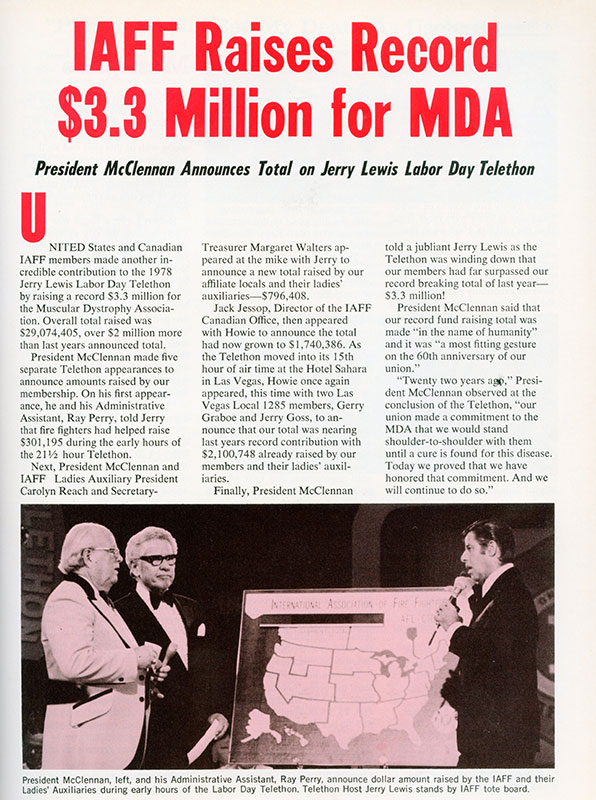
Four federal fire fighters perish due to a wind-whipped blaze on a military installation in Tranquillion Peak, California, that blackened 10,000 acres of brush.
Four Syracuse, New York, fire fighters are killed while searching for a resident of an apartment building who had already escaped the blaze. The blaze in the rooming-house was likely caused by two candles left burning on a makeshift candle holder made from a Styrofoam wig stand. The men died from asphyxiation and smoke poisoning when their air tanks ran out of air before they could exit the building.
Two Findlay, Ohio, fire fighters perish while trying to rescue two youths from the Blanchard River. The two young men had launched a raft six miles from the Blanchard River dam. The raft spilled due to the raging waters and the two were trapped at the base of the dam. The fire fighters who attempted to rescue them also drowned.
Six New York City fire fighters die when a supermarket roof collapses, hurling them into the flaming debris below.
Public relations – which really translates to ‘good communication’ – must be used to blunt the attack and present our story to the community. Public relations is an art, not a precise science.
William H. McClennan, IAFF President (1968-1980)
Survivors of fire fighters killed in the line of duty are entitled to a $50,000 benefit once the Law Enforcement Assistance Administration approves their claim.
The IAFF launches a series of nine articles written by the members of the Public Relations Committee about tips for effective PR, which include appointing a publicity chairman for every local, writing articles on union stationary and keeping the story short, among other recommendations.
The IAFF recommends to the National Institute of Occupational Safety and Health (NIOSH) and the Occupational Safety and Health Administration (OSHA) that a high-performance breathing apparatus standard be developed.
The IAFF makes a Scholarship Fund lighter available to members for $6.50.
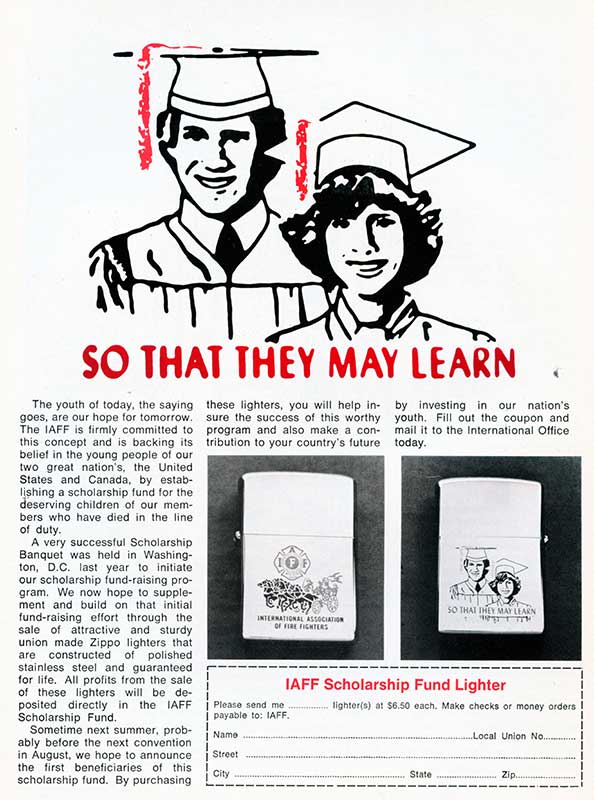
September 1978 has the greatest number of strikes in a one-month timeframe – six. These are the most strikes in a 30-day period since the no-strike clause was struck from the IAFF Constitution at the Toronto Convention in August 1968. The six strikes occurred in Wichita, Kansas; Chattanooga, Tennessee; Manchester, New Hampshire; Brazil, Indiana; Butte, Montana; and Biloxi, Mississippi.
The first solar-powered fire station in the world goes into service in Dallas, Texas.